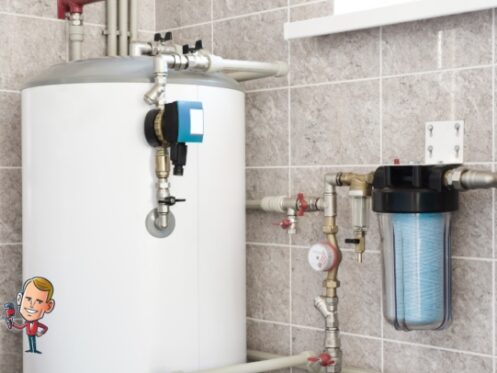One of the biggest issues with traditional water heaters is that they can be prone to leaking. If you notice water dripping down the sides of your water heater or pooling up on the floor, it is essential that you have the unit checked out and the problem repaired as soon as possible. There are several different issues that can cause a water heater to leak, and here is everything you need to know about the possible causes and how they can be fixed.
Determining Where the Leak Is Coming From
The first step toward troubleshooting a leaking water heater is to determine where the leak is. This is important as it makes it easier to determine what is causing the leak and how it can be fixed. Most water heater leaks are something that will need to be taken care of by a professional plumber. The only real exception is if the unit is leaking due to the drain valve not being fully closed. Depending on where the leak is coming from and what is causing it, a plumber may be able to repair the problem, or you may need to have your water heater replaced.
Relief Valve Leaks
All water heaters, except for tankless units, have a relief valve that works to prevent the temperature and pressure inside the tank from becoming too high. This is an important safety mechanism; without it, the tank could possibly explode if the pressure gets too high.
As the temperature inside the tank increases, so does the pressure. If the pressure ever gets too high, the relief valve will automatically open and allow some water to drain out to reduce the pressure. Water heaters are designed to be able to safely operate at up to 160 degrees Fahrenheit, but you typically shouldn’t ever set the unit to higher than 140 degrees Fahrenheit due to the risk of scalding.
The relief valve really shouldn’t ever activate unless there is some issue causing the heater to make the water too hot. This most commonly happens because the temperature control has malfunctioned, causing the water heater to fail to properly regulate how much heat it produces. In this case, the solution is to have a plumber replace the temperature control.
As water heaters age, the relief valve starts to wear out. When this happens, the valve may no longer seal properly and can start to leak. If the valve is leaking, a plumber will need to drain the water heater tank and then replace the valve.
In some cases, sediment can also get stuck inside the valve and prevent it from closing after it activates. While this is an easy fix, you still need to have your water heater inspected to determine what is causing the pressure to get high enough that the valve activates.
Water Line Leaks
Another possibility is that the cold-water line feeding into the water heater or the hot water line coming out of it is leaking. This typically occurs because the pipe fittings are either loose or worn out. In some cases, the solution is as simple as tightening up the fitting to ensure it can’t leak. If the fittings are damaged, you will need to have them replaced by a plumber. The same is also true if the copper pipes themselves are damaged and have sprung a leak.
Drain Valve Leaks
Near the bottom of the water heater tank is a drain valve where you can attach a hose whenever the tank needs to be drained or flushed. If you notice water dripping out the drain valve, the first thing to do is check to make sure it is fully closed.
Different brands and models of water heaters use different types of valves, but most will use either a ball valve or a gate valve. Ball valves have a straight handle, while gate valves have a round handle like what you’ll find on most hose bibs. If your water heater has a ball valve, the handle should be at a 90-degree angle to the valve. To check if the valve is closed, gently push the handle as far away from the valve as you can. For gate valves, you will want to turn the handle clockwise to make sure it is fully shut.
If the valve is shut and still leaking, it means that it is worn out and no longer has a watertight seal. Again, the solution is to have a plumber remove the faulty valve and replace it with a new one.
Gasket Leaks
Electric water heaters require gaskets that work to seal off the heating element. This prevents water from getting inside the element and damaging the wiring or causing electrical problems. Over time, these gaskets can sometimes wear out or become loose and no longer seal properly. When this happens, it will cause water to start leaking out of the bottom of the unit. This is an easy problem to fix. After draining the tank, a plumber will inspect the gaskets and replace any that don’t seal properly.
Water Leaking From the Tank
This is the biggest issue and means that you will need to have your water heater replaced. Water leaking from the tank itself is a serious problem and means that the tank is corroded. This is something you will want to get taken care of immediately. If not, there is a decent chance that the tank will soon fail completely. Should this happen, all the water will come rushing out and lead to serious flooding and potentially major water damage.
Rust and corrosion are the main reason that most water heaters fail. Inside the water heater tank is a long steel wire coated in either magnesium, zinc, or aluminum. This is known as an anode rod, and it uses electrolysis to prevent rust from damaging the water heater tank. The rod works by attracting rust and contaminants in the water. Instead of damaging the metal tank, any rust in the water corrodes the anode rod instead.
As the water heater ages, the anode rod often becomes corroded enough that it can no longer do its job properly. If the anode rod isn’t replaced, all the rust can quickly damage the tank and cause it to develop a leak. This is one of the reasons why you should always have your water heater professionally inspected and maintained every year so that you can ensure the anode rod is still in good shape and working properly.
It is also important to have your water heater flushed every year to remove all the sediment from the tank. If the tank isn’t flushed regularly, the sediment can build up and cause numerous issues. In gas water heaters, sediment buildup often results in hot spots at the bottom of the tank, and this can weaken the metal and speed up the rate of corrosion. Sediment buildup can also cause the heating elements to fail more quickly and need to be replaced. The only way to prevent these problems is with annual water heater flushing.
At Cal’s Plumbing, we work on all types of water heaters and can quickly determine why your unit is leaking and how to fix it. We also install and repair water softeners, water filtration systems, pressure regulators, and all types of kitchen and bathroom plumbing fixtures. Our team can also take care of any plumbing repairs, drain cleaning, and gas or sewer line services you may need, and we work on both residential and commercial plumbing systems for customers throughout the Tucson area. To schedule a water heater inspection or any other plumbing service, contact us today.





